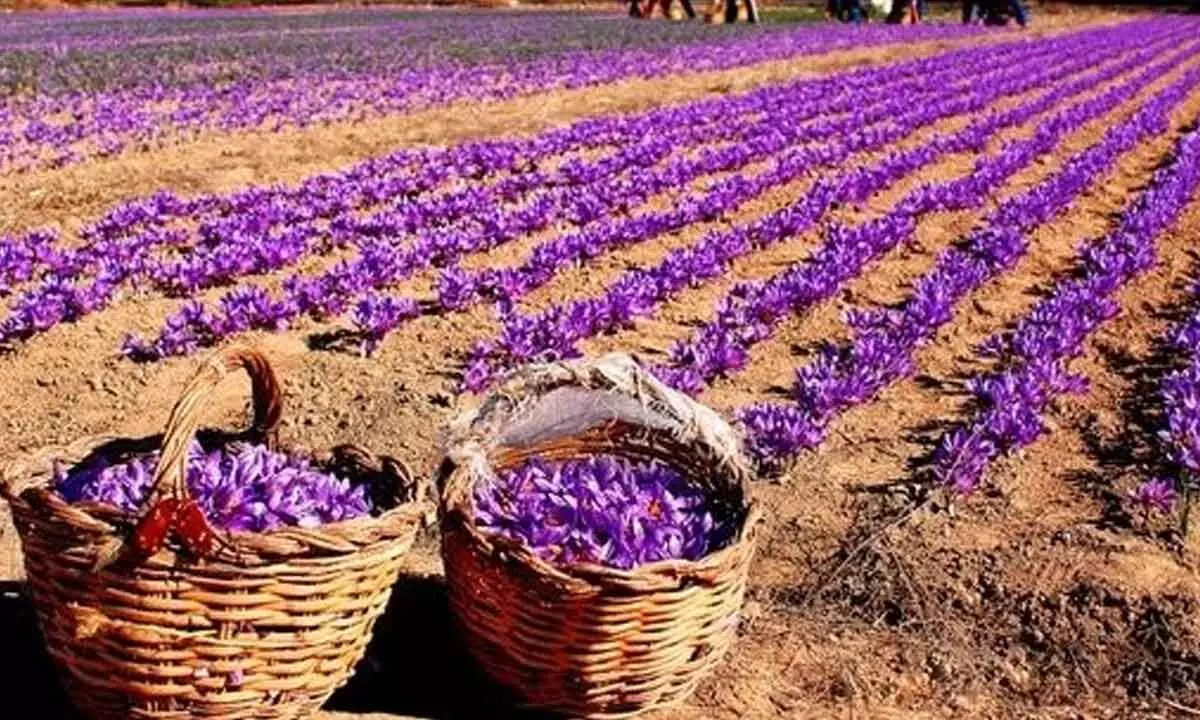Live
- SC to hear pleas challenging Places of Worship Act today
- GMR Airports Unveils AI-Powered Digital Twin Platform to Transform Airport Operations
- India poised to become leading maritime player: PM Modi
- Top Causes of Kidney Stones and How to Recognize Silent Symptoms
- India’s renewable energy capacity logs 14.2 pc growth at 213.7 GW
- Winter Session of Odisha Assembly adjourned sine die
- Biden calls Trump's tariff approach 'major mistake'
- After Drama Over Eknath Shinde’s Chief Minister Race, Maharashtra Cabinet Formation Faces New Tensions
- Egyptian FM, Blinken discuss recent developments in Syria
- Iran's supreme leader says Syria's developments result of US-Israeli 'plot'
Just In
Visakhapatnam: From verdant fields of J&K, saffron corms land in Chintapalli


Saffron crop to be cultivated in Chintapalli region on an experimental basis by ANGRAU-RARS
- Cultivation of costly spice is taken up in three different conditions by RARS
- Saffron cultivation is experimented by ANGRAU in Chintapalli region
Visakhapatnam: From the verdant fields of Jammu and Kashmir, saffron corms make their way for cultivation trials in Chintapalli region.
Initiated by Acharya NG Ranga Agricultural University (ANGRAU)-Regional Agricultural Research Station in Chintapalli, the maiden cultivation of saffron is being taken up on an experimental basis.
With already 200-kg of saffron corms reaching RARS, the cultivation will be taken up in two different spells following a gap of a month-long interval after the completion of the segregation process.
As a part of it, RARS intends to grow the crop in three different conditions such as in shade net, ventilated glass house and open field. Based on the output and sustainability of the crop, the cultivation will further be extended to farming communities and thereby contributing to the overall production of the spice.
The project is being implemented with the technical support of Purple Springs based in Madanapalli, a start-up company with which the ANGRAU signed a memorandum of understanding.Saffron, scientifically known as Crocus Sativus L, is the most expensive crop that belongs to the Iridaceae family. Primarily, they are grown in Pampore region of Srinagar and Kishtwar district of Jammu and Kashmir. “Saffron cultivation is confined to a certain geographical landscape in Jammu and Kashmir. Given the favourable weather conditions in Chintapalli region, we wanted to experiment with the cultivation of the crop. Based on its survival rate, it would be recommended to the farmers in the region,” shares M Suresh Kumar, associate director of Research, Regional Agricultural Research Station.
The annual demand for saffron in India is estimated to be 100 tonnes as against its production that is less than 6.46 tonnes. Globally, the production of saffron stands at 300 tonnes per annum. Iran is the largest producer of the spice, followed by Spain and India.
According to the university officials, saffron thrives well in temperate dry climate at altitudes ranging from 1,500-2,800 metre above mean sea level. Apparently, temperature is considered the most important environmental factor controlling the crop’s growth and flowering.
Giving details of the cultivation at RARS, L Prasanthi, director of research, ANGRAU, says, “Once the project is successful, the saffron cultivation will be recommended to farmers so that they will not only enhance their income but also their socio-economic conditions.”
Earlier, the ANGRAU trained tribal farming communities in floriculture. The endeavour focused on cultivating flower crops such as Gladiolus, Tulip, Lilium, Chrysanthemum and Gerbera varieties at farmers’ fields in Chintapalli

© 2024 Hyderabad Media House Limited/The Hans India. All rights reserved. Powered by hocalwire.com






